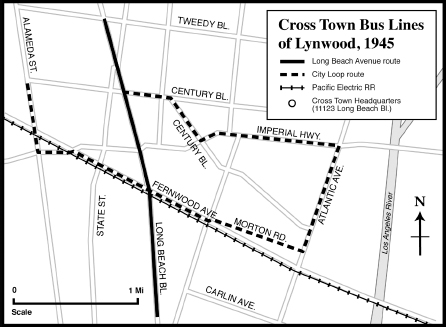
CHAPTER 7
BUSES RUN IN THIS FAMILY
The Carsons
Mention the name Carson to a Southern Californian, and the city of Carson most likely comes to mind. That city is named after John Manuel Carson, son of George Henry Carson and Maria Victoria Dominguez. The Dominguezes were the owners of the forty-eight-thousand-acre Rancho San Pedro. Part of this Spanish land grant, which covered most of southern Los Angeles County, became the city of Carson in 1968.
However, much of the public transit history of this area rests with another, unrelated Carson family. Dean Carson came to Southern California after World War I and founded a local bus line in 1945; this simple operation grew into a transit company spanning nearly all of southern Los Angeles County, plus parts of Orange County. His descendants own and operate several bus-related industries to this day.
DEAN CARSON
Dean Carson was born on October 31, 1895, in the town of Washburn, Wisconsin. When he became old enough, Dean worked on the family farm until 1918, when he was called to serve in World War I. After the war, Dean settled in Los Angeles and then relocated to Lynwood, a predominately agricultural suburb fifteen miles southeast of downtown Los Angeles. In Lynwood, he owned a heavy equipment rental company and a sign painting business.
Dean married Carrie Swanby and had several children, including Nadeane (born in January 1926), David (born in August 1927) and James (born in April 1930).
DEAN ENTERS THE BUS BUSINESS
Public transit in Lynwood was limited to a Pacific Electric rail line between Los Angeles and Santa Ana via Watts, as well as a Pacific Electric bus line along Long Beach Boulevard linking Huntington Park and Long Beach.
In 1943, Dean Carson, encouraged by his son David and City Councilman Cliff Schorck, applied for and was granted a twenty-five-year franchise to operate a bus route within Lynwood. However, during World War II, buses were severely rationed. It was not until November 1945 that the Carsons were able to obtain their first two buses.

Cross Town Bus Lines, Lynwood, 1945. Author’s collection/Mapcraft.
Nearly all members of the family drove: Dean, David, James and Nadeane (female bus drivers were rare, although many drove during the war). David left Cross Town in 1952 to become vice-president of sales at Crown Coach, a major manufacturer of buses.
When the Carsons started expanding service outside Lynwood, they needed to apply to the California Public Utilities Commission (CPUC) for the necessary certificate.
CPUC let Cross Town expand where there was no existing transit service: westward on Imperial Highway to Hawthorne and southward to Compton. However, when the Carsons applied for a bus line from Lynwood to Huntington Park, the Los Angeles Transit Lines protested. LATL already ran a bus between Huntington Park and Lynwood and did not welcome competition. In September 1949, CPUC sided with LATL and rejected Cross Town’s application.
Dean was livid. “There is no hope for expansion of my line under the present setup in the PUC,” he said. “It’s impossible to get a fair shake with them. The PE and the LATL are too big for me to buck by myself and in spite of the fact that the two big companies are set up to get 30 cents from anyone wanting to get anywhere, I have been unable to get approval for a cheaper service.”
NADEANE’S POLKA DOT BUSES
After CPUC rejected Cross Town’s extension to Huntington Park, Nadeane approached the Huntington Park City Council with a plan to operate a local bus service entirely within the city; CPUC permission would not be required. The council, although supportive of the idea, was concerned that the city might have to subsidize the bus service. But after LATL raised fares on its local bus route through Huntington Park in December 1950, the council voted to support Nadeane’s bus line. Service began on December 18, in the middle of the Christmas shopping season.
Cross Town Lines of Huntington Park was a separate company from the rest of the Cross Town/Southern Cities route network. Nadeane owned and managed the company and even drove a bus occasionally. The buses sported a whimsical “polka dot” theme, and the drivers wore polka-dot ties.
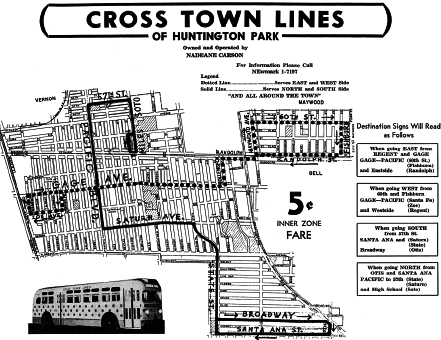
Cross Town Huntington Park schedule. Courtesy Dorothy Peyton Gray Transportation Library.
The Carsons operated similar one-city services in Fullerton, Norwalk and Downey. The Fullerton route was expanded to Anaheim, but the Norwalk and Downey services lasted only one or two years.
CHARTERS AND CAMPFIRE GIRLS
Cross Town Bus Lines also provided charter bus service. Most of Cross Town’s charter business involved transporting youth groups to campsites.
Before 1963, CPUC did not regulate charter buses, but local jurisdictions did. In 1950, Los Angeles authorized six charter bus companies to do business within the city. Cross Town Bus Lines applied for a license but was turned down.
However, Cross Town had already entered into an agreement to take a group of Campfire Girls to a mountain camp. On July 20, 1950, Dean, James and another driver arrived at the appointed place and time. They loaded the girls onto the buses and had just started on the trip when the city transportation inspector and the police showed up. They unloaded the buses and left the bewildered girls sitting on the sidewalk, while Dean and the other drivers were taken off to jail. The trip organizers hurriedly arranged transportation with one of the city’s “approved” charter bus companies. The trip finally left—three hours late and in the heat of the day.
The press directed outrage at the city for its handling of the situation. “Inexcusable Stupidity of Officialdom” thundered a Herald-Express newspaper editorial, while the Los Angeles Times printed pictures of tearful girls and bus drivers being arrested.
The City of Los Angeles eventually granted Cross Town permission to operate charter bus service within Los Angeles.
ACQUISITION AND EXPANSION
Barred from expanding northward into LATL territory, Dean turned his attention to several small bus operators in the southern part of Los Angeles County. Many of these bus companies had financial difficulties, and Dean thought that acquiring and consolidating them into one larger operation would be more efficient. CPUC, apparently in agreement, granted permission for most of Dean’s acquisitions.
Dean first acquired Southern Cities Transit, which operated in and around Compton. Since 1945, SCT had been owned by the Crown Coach Company. Not finding the system profitable enough, Crown sold SCT to the Carsons in April 1954. Next on Dean’s list was the Holbrook–Benton Bus Line in December 1954. This company served the cities of Huntington Park, Bell, Whittier, Norwalk, Artesia and Bellflower. Another Crown-owned system, Whittier Bus Lines, was acquired in 1957.
In 1958, Dean acquired Sunset Stages, a transit system operating in Inglewood and the three beach cities (Redondo, Manhattan and Hermosa). Under Carson ownership, service on Hawthorne Boulevard between Inglewood and Torrance was improved to run every ten minutes, a rarity outside Los Angeles proper.
Governmental subsidies for public transit were nonexistent, so each segment of every route had to justify its existence by generating fare revenue. Dean continued to adjust bus routes in all of his systems, adding a portion of a route here, deleting a route segment there and rerouting yet another route elsewhere. He made route changes so quickly that he sometimes failed to file them with CPUC, or did so after the fact. Although CPUC could have fined or otherwise sanctioned Dean, the Commission’s concern about the financial status of these bus lines usually meant that he was simply admonished to file the proper paperwork next time.
Dean acquired his last bus company in 1959. The Southland Bus Company, owned by William Bourne, operated between Long Beach and Anaheim, serving Disneyland and Knotts Berry Farm.
UNIONS AND STRIKES
The increasing cost of wages paid to drivers, mechanics and other employees affected Dean’s bus companies. Employees unionized and demanded higher wages. To meet the higher labor costs, Dean’s choices were: cutting back service; raising fares, if CPUC gave permission; or refusing to give in to the employees’ demands, risking a strike.
In July 1953, the drivers and mechanics of Southern Cities Lines, at the time controlled but not fully owned by Dean, went on strike for a wage increase. At the end of the strike, the employees got their raise, and fares were raised from fifteen to twenty cents.
Another strike took place in October 1954, after Dean had acquired the Benton–Holbrook routes. This two-month-long strike turned violent when gunshots, fired from a passing car, struck two buses at the depot. Fortunately, no one was hurt.
Dean’s treatment of his employees landed him in court at least twice. In 1955, a judge ordered him to pay back wages withheld during one of the strikes.
CONSOLIDATION
Although Dean had attempted to consolidate his bus companies into one large operation in 1954, both he and the CPUC subsequently decided that it was not quite the right time to do so. But in late 1959, the CPUC finally allowed Dean to consolidate his bus companies. The original Lynwood Cross Town Bus Lines, Southern Cities Transit, the Holbrook–Benton Bus Lines and Southland Bus Lines were all merged into a new company called Cross Town Suburban Bus Lines. The local services in Fullerton, Downey and Huntington Park were not included in the consolidation but remained separate entities owned by various Carson family members.
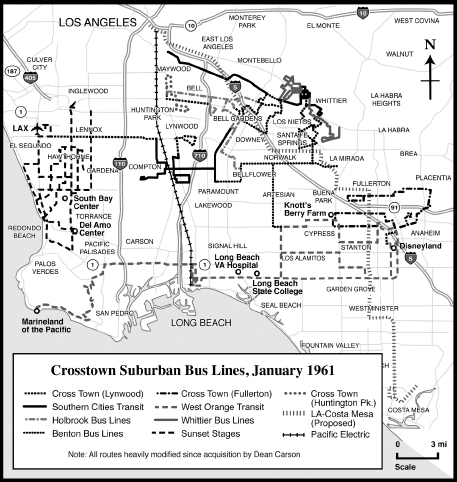
Cross Town Suburban Bus Lines, 1961. Author’s collection/Mapcraft.
AT THE END OF THE ROAD
By 1960, Cross Town Suburban Bus Lines was operating eighty-four buses on twenty-two routes, covering roughly 720 square miles. But consolidation was not sufficient to make the transit system profitable. Cross Town’s service area was still mostly rural. New housing developments built were low density and not conducive to high public transit use. Besides, most of the people moving to the area already owned or planned to purchase automobiles.
Dean proposed a new express route between Costa Mesa and downtown Los Angeles, the first ever Cross Town bus route to enter the central city. But LAMTA, which operated express bus service along the Santa Ana Freeway, opposed Cross Town’s application. The Los Angeles Board of Public Utilities and Transportation also opposed the new route because Cross Town had not arranged for an off-street layover area in downtown Los Angeles. CPUC rejected Dean’s application.
Hassles with various government agencies, financial difficulties in obtaining new buses and his own personal health problems convinced Dean to retire from the transit business. In January 1961, Dean sold the Cross Town Suburban Lines, plus the Fullerton and Huntington Park operations, to LAMTA for $346,093. By February 15, LAMTA buses were rolling where Cross Town buses once did. Many of the Cross Town drivers and mechanics became LAMTA employees.
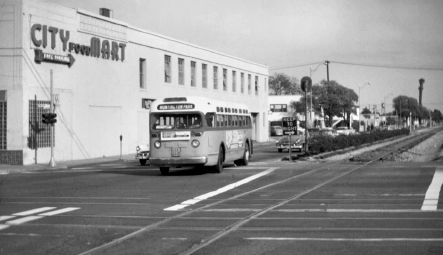
Cross Town Suburban Bus Lines. Courtesy Dorothy Peyton Gray Transportation Library.
CARSONS: THE SECOND GENERATION
While Dean enjoyed his sunset years, his two sons, David and James, continued in the bus business.
In 1962, shortly after Cross Town was sold, David left Crown Coach and founded the American International Bus Exchange. AIBE acted as a broker between transit companies wishing to sell older buses and bus operators seeking to save money by buying used equipment. David facilitated the sale of the last of LAMTA’s streetcars to Cairo, Egypt, and its electric trolleybuses to Mexico City. David’s three sons—Dean, Dwight and Dale—helped in the family business with tasks ranging from repairing and maintaining buses to selling them.
David sold AIBE to the American Chromalloy Company in 1977. The company renamed AIBE to Hausman Bus Sales. David retired shortly thereafter, although his sons Dean and Dale stayed with the new company.
After the Cross Town sale, James worked at LAMTA (which became the Southern California Rapid Transit District in 1964) as a division manager. In 1971, he moved to San Diego Transit to become that agency’s assistant manager. One year later, James relocated to Hawaii and became assistant manager of Honolulu Transit (“The Bus”). By 1972, he had become president of Hawaiian Scenic Tours.
In 1975, James returned to the mainland to head the Western Division of ARA Services, owner of Hawaiian Scenic. ARA, located in Encino, operated school and charter buses. Its vehicles provided athlete transportation during the 1984 Los Angeles Olympics. Shortly after the Games, Laidlaw Transit of Toronto, Canada, acquired ARA’s bus operations; James retired about a month later.
COMMUTER BUS LINES
Douglas Bus Lines (DBL) was a commuter buspool service dating from the years after World War II, when it carried employees to the Douglas Aircraft plant in Long Beach. Later, DBL expanded to serve other businesses. DBL’s motley fleet of former RTD and Greyhound buses constantly had mechanical and safety problems, often getting the firm in trouble with CPUC.
In 1977, James and former Cross Town employee William Bourne purchased DBL. Since the bus line no longer exclusively served Douglas facilities, they renamed it Commuter Bus Lines (CBL). They disposed of the worst of the secondhand vehicles and expanded service. James managed the existing Southern California operations, while William, formerly the manager of the Sacramento Regional Transit System, set up a route network serving the Sacramento metropolitan area.
In addition to its home-to-work commuter buspool service, CBL offered charter service, racetrack specials to Santa Anita and Hollywood Park, a “gamblers special” from Sacramento to Reno, airport buses to the Sacramento Airport and a shuttle bus serving California state offices. CBL also operated Yolobus, a local transit system between Sacramento and Yolo County.
INNOVATIONS IN COMMUTING
Traditionally, commuter buspools, including CBL’s, carried only employees of a single employer. For example, if the bus was going to the Rockwell plant in El Segundo, it would not accept passengers working for a different company, even if that company was next door. CBL considered that practice to be inefficient. It claimed that if it could carry anyone to El Segundo on any bus, regardless of employer, then more of its buses would run full and its operation would be much more efficient in terms of both vehicle and energy usage.
CBL proposed its buspool routes be allowed to carry anyone wanting to travel to any employer in what was called the “LAX–El Segundo Employment Area.” Competing buspool operators objected, citing employer concerns about confidentiality and corporate espionage. In 1983, CPUC sided with CBL, agreeing that dedicated buses restricted to employees of one employer was unreasonable.
INSURANCE TROUBLES AND SALE TO KIRKMAN
In December 1985, Transit Casualty, CBL’s insurance carrier, abruptly went out of business. CPUC immediately suspended CBL’s certificate due to lack of insurance. CBL’s operations in Southern California and in Sacramento were pulled off the street. Replacement insurance would cost nearly four times as much as the Transit Casualty coverage.
T.R. Kirkman, who owned stock in the Pacific Trailways bus system, bought CBL from Bourne and Carson in March 1986. Because of his partial ownership of Pacific Trailways, Kirkman was able to obtain insurance at a much lower rate. Under Kirkman, CBL added new routes from Orange County and the San Fernando Valley to downtown Los Angeles.
Dale Carson, son of David Carson, had been the general manager of CBL since March 1986. In December, Kirkman sold the Southern California division to Dale and his sister, Dawn, while retaining the Sacramento-based services.
LYNWOOD TROLLEY
In mid-1986, Lynwood city officials decided to provide a local shuttle bus to supplement the service provided by RTD. A half-cent sales tax provided funds for cities to set up local transit systems within their borders.
The city bought two red “rubber-tired trolleys” (small buses designed to resemble streetcars) and contracted with Commuter Bus Lines to operate them on a route looping around the city. CBL stored and maintained the trolleys at its yard at 11123 Long Beach Boulevard—the same yard where Dean Carson had started Cross Town Bus Lines nearly forty years earlier.
The Lynwood Trolley started service in late December. The trolleys charged no fare, and by late February, ridership was about fifteen thousand per month. Senior citizens and the handicapped enjoyed their newfound mobility, while the younger set used the trolleys to get home from after-school activities.
The Lynwood Trolley added two new routes in 1990. A fourth line connecting downtown Lynwood to the Metro Blue Line was added in 1992. The free ride lasted until 1994, when a twenty-five-cent fare went into effect.
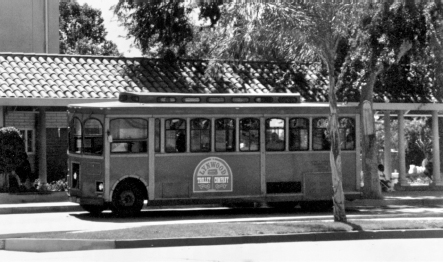
Lynwood Trolley. Author’s collection.
In 2000, Paul Richards, a former mayor of Lynwood, abused his authority by forcing Commuter Bus Lines, and other companies with city contracts, to pay for consulting services provided by a company owned by Richards’s family. CBL was never implicated in any wrongdoing. However, all city contracts were rescinded in 2003, and another contractor was selected to operate the Lynwood Trolley.
The Lynwood Trolley was the last of the Carson bus operations. As other private bus operators entered the field, the Carsons focused on maintaining, selling and leasing transit vehicles rather than providing bus service. During the late 1980s and early ’90s, Commuter Bus Lines obtained contracts with the Orange County Transit District, the University of California–Los Angeles and other entities to maintain and refurbish buses.
THE CARSON LEGACY CONTINUES
Dean and Dale Carson started several companies during the late 1980s, all dedicated to the sale, repair, refurbishment or leasing of buses and intercity coaches. Complete Coach Works refurbishes and upgrades used buses, and Shuttle Bus Leasing offers temporary rental of buses (for airport shuttles and the Olympic Games). Transit Sales International buys used buses from transit agencies and then refurbishes and resells them. TSI has had much success selling buses on the international market, ranging from Canada, Mexico and Central America to China and the Philippines.
Dean’s sons, David and Kyle, as well as Dale’s sons, Bradley, Elliot and Kris, participated in the family businesses as soon as they were old enough. They are all currently employed in one of the Carson companies.
EPILOGUE
LAMTA and its successor agencies (RTD, MTA/Metro) have operated the former Cross Town bus routes since their acquisition in 1961; service in Orange County was transferred to the Orange County Transit District in the mid-’70s. The transit agencies have renumbered, restructured and rerouted these lines so often it can be difficult to trace the former Cross Town bus routes.
The cities of Downey, Norwalk and Huntington Park, once served by Carson family–owned bus companies, all have their own municipal bus lines. Also still operating is the Lynwood Trolley, the resurrection of Dean Carson’s original local line, but with a different contractor and a new name—Lynwood Breeze. The former Cross Town Bus/Lynwood Trolley yard at 11123 Long Beach Boulevard was sold to an adjacent shopping center.
In 2010, Complete Coach Works opened a plant in Puerto Rico to refurbish buses owned by the Metropolitan Bus Authority in San Juan. Bradley Carson manages the forty-thousand-square-foot facility, capable of rehabbing seventeen buses at once.
Bradley, along with his siblings and cousins, represents the fourth generation of Carsons in the bus business. If the past is a predictor of the future, then it is certain that their children, and maybe their grandchildren, will keep the family businesses going and continue the legacy started by a sign painter in Lynwood back in 1943.